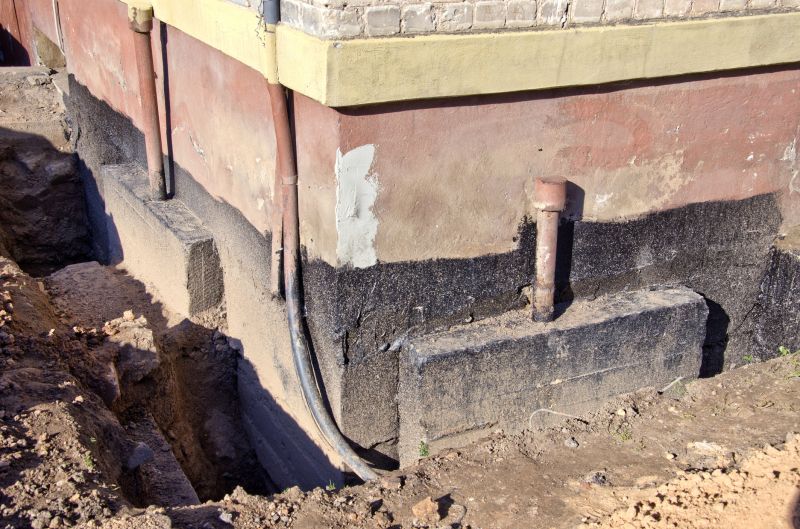Top Products For Leaking Foundation Repairs To Restore Stability
Explore the leading solutions designed to effectively seal leaks and strengthen your foundation for lasting safety.
 Addressing leaking foundations is a critical aspect of maintaining the structural integrity and safety of a building. When water seeps through the foundation, it can cause significant damage over time, including cracks, mold growth, and weakened structural components. To effectively manage and repair leaks, a variety of products are available that cater to different types of foundation issues and repair needs. These products are designed to seal, waterproof, or reinforce foundation surfaces, helping to prevent further water intrusion and potential damage.
Addressing leaking foundations is a critical aspect of maintaining the structural integrity and safety of a building. When water seeps through the foundation, it can cause significant damage over time, including cracks, mold growth, and weakened structural components. To effectively manage and repair leaks, a variety of products are available that cater to different types of foundation issues and repair needs. These products are designed to seal, waterproof, or reinforce foundation surfaces, helping to prevent further water intrusion and potential damage.
Top Overall Option
Multi-Purpose Foundation Sealant
A versatile liquid sealant designed for both interior and exterior foundation repairs. It offers strong adhesion, flexibility, and resistance to water penetration, making it suitable for sealing cracks and preventing leaks in various foundation materials. Easy to apply with a brush or spray, it provides a reliable barrier against moisture infiltration when properly used. Its durability and compatibility with different substrates make it a popular choice for homeowners seeking a comprehensive solution.
Types of Products For Leaking Foundation Repairs
Liquid Sealants
Fluid-based products that can be brushed or sprayed onto foundation surfaces to create a waterproof barrier.
Waterproof Coatings
Thick, durable layers applied to exterior or interior surfaces to prevent water penetration.
Crack Injection Kits
Systems that inject epoxy or polyurethane foam into cracks to seal leaks from within.
Patching Compounds
Materials used to fill and repair cracks, holes, or damaged areas on foundation surfaces.
Waterproof Membranes
Sheet-like barriers that are applied to foundation walls to provide a continuous waterproof layer.
Hydraulic Cement
Specialized cement that expands as it cures, ideal for sealing active leaks and cracks.
Polyurethane Foam
Expanding foam used to fill voids and cracks, providing a flexible seal against water intrusion.
Epoxy Resins
Strong adhesives used for structural repairs and crack sealing within foundations.
Drainage Mats
Materials installed behind foundation walls to direct water away and reduce hydrostatic pressure.
Foundation Waterproofing Paints
Paints formulated to resist water and moisture, applied directly to foundation surfaces.
Drainage Systems
Components like French drains or sump pumps that help divert water away from foundations.
Vapor Barriers
Sheets or coatings that prevent moisture vapor from passing through foundation surfaces.
Sealant Tape
Flexible tapes used to temporarily or permanently seal cracks and joints.
Foundation Repair Kits
All-in-one kits that include multiple products for comprehensive foundation leak repairs.
Popular Choices
A widely used product for sealing small to medium cracks in concrete foundations.
Commonly applied to foundation walls to provide an extra layer of water resistance.
Popular for its flexibility and ability to expand within cracks, sealing leaks effectively.
Often chosen for active leaks due to its quick-setting properties and strong adhesion.
Favored for structural crack repairs and sealing leaks from the inside.
Effective for managing water flow and reducing hydrostatic pressure behind foundation walls.
Commonly installed to remove accumulated water and prevent basement flooding.
Popular for exterior foundation waterproofing projects.
Convenient for quick fixes and sealing joints or small cracks.
All-in-one solutions that include various products tailored for leak repairs.
Used to control moisture vapor transmission through foundation surfaces.
Preferred for sealing joints and cracks that experience movement.
Commonly used for structural repairs and leak sealing in concrete foundations.
Applied to exterior walls for an added layer of water resistance.
Popular for filling voids and sealing leaks from within the foundation.
Foundation repair products range from liquid sealants and waterproof coatings to specialized patching compounds and injection systems. Liquid sealants are easy to apply and can be used to coat interior or exterior surfaces, creating a barrier against moisture. Waterproof coatings are often thick, durable layers that adhere to concrete or masonry, providing long-lasting protection. Patching compounds are suitable for filling cracks and holes, restoring the integrity of the foundation surface. Injection systems, which involve injecting epoxy or polyurethane foam into cracks or voids, are effective for sealing leaks from within the foundation structure.
Choosing the right product depends on the severity of the leak, the foundation material, and the specific conditions of the site. Proper application and selection of the appropriate product type can significantly improve the effectiveness of the repair and help prolong the lifespan of the foundation. It's important to carefully evaluate product specifications, compatibility with existing materials, and ease of use when planning a repair project. Consulting with a foundation specialist or contractor can also provide valuable insights into the most suitable options for your particular situation.
Key Buying Considerations
- Assess the severity and location of the leak to determine the most suitable product type.
- Compatibility with existing foundation materials such as concrete, brick, or stone.
- Ease of application and whether professional assistance is needed for proper installation.
- Durability and resistance to ongoing water exposure over time.
- Flexibility of the product to accommodate foundation movement or settling.
- Ability to seal active leaks effectively without causing further damage.
- Compatibility with interior or exterior application depending on repair needs.
- Potential for future repairs or maintenance when selecting a product.
- Product safety and any necessary protective equipment during application.
- Cost considerations relative to the scope of the repair project.
- Availability of comprehensive repair kits versus individual products.
- Environmental conditions such as temperature and humidity during application.
- Brand reputation and customer feedback on product performance.
- Warranty or guarantee provided with the product for peace of mind.
- Adherence to local building codes and regulations.
